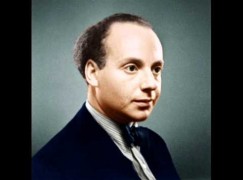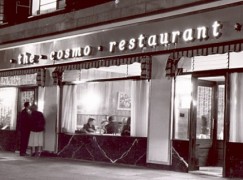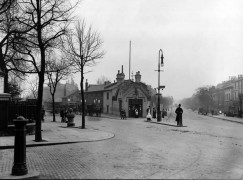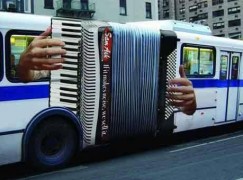A piece I wrote for this weekend’s JC magazine
When Swiss Cottage spoke German
© Norman Lebrecht, all rights reserved
By the time my generation moved in, not much was left of the Emigration beyond a tinkling of pianos in Canfield Gardens and a daylong cluster of grey heads in the Cosmo restaurant. The Emigra-zion, always capitalised, ending in a Hebrew-German twist, was made up of Jews who fled Europe between 1933 and 1939, settling in a triangular axis around an Alp-themed pub on a busy North London thoroughfare. What drew the refugees to Swiss Cottage is uncertain, but they gathered in such critical mass that bus conductors would shout, as they neared the pub, ‘this stop for British West Hampstead!’
Ranging across two postal districts, NW3 and NW6, they included the founder of psychoanalysis, a future Nobel Prize winner for Literature, the pioneering chronicler of Britain’s buildings and any number of artists, scientists and musicians. Hitler’s loss hit England’s Lane. So close a concentration of great minds was never equalled in any other time or place. It would be too easy to fill this article with uplifting tales of displaced celebrity, but nostalgia serves no purpose. What concerns me today about the Emigration is how massively it transformed a humdrum part of London and how productively it assimilated.
In the early 1980s I got to know Berthold Goldschmidt, a composer who arrived from Berlin in 1935 and spent the rest of his long life in a one-bed, cold-water flat on Belsize Park Gardens. ‘It was cheap,’ said Berthold, ‘and close to the concert halls.’ Culture, I was given to understand, was an existential necessity for the Emigration.
As soon as exiles had saved a few pennies from their desperately menial work as domestic servants and factory workers, they descended on Queens Hall and the Royal Albert Hall for a full symphonic immersion. It was not uncommon after concerts for conductor and soloist to ride home to Swiss Cottage on the same bus as half the audience. Sir Thomas Beecham, ever the entrepreneur, moved his Royal Philharmonic Sunday concerts to the Odeon cinema behind the pub.
A Freie Deutsche Kulturband was formed in Hampstead by, among others, the best-selling writer Stefan Zweig and the film director Berthold Viertel. They performed English plays in German and staged art exhibitions. An Anglo-Austrian Music Society was founded with Ralph Vaughan Williams as patron. A Blue Danube club catered to cabaret. Goldschmidt wrote a song, The Ex (Der Verflossene), for his wife’s girlfriend to perform there. Decades later, Ute Lemper recorded it for Decca.

Copyright lawyers called the composer, asking where he had found the text. In a Berlin magazine in 1928, he replied. The lawyers called again. They could find no trace of the poet, Alice Eckert-Rotholz. ‘Have you tried the London telephone directory?’ said Berthold, assuming that anyone who wrote for a non-Nazi Berlin paper would wind up in Swiss Cottage. Sure enough, Alice was found to be living two streets away from him.
Although just 60,000 refugees were admitted to the UK in the 1930s, it seemed as if an entire civilisation had been transplanted. The newcomers soon left their mark on the environment. A Bauhaus residence was built on Lawn Road, a modernist penguin pool at Regents Park Zoo. Bookshop windows were enlivened by elegant new covers, designed and published to continental standards.
Phaidon, the Viennese art publisher, resumed operations in Hampstead. Its best-seller, the Story of Art, was written by Ernst Gombrich, of Briardale Gardens. In a cottage near the Heath, Nikolaus Pevsner wrote The Buildings of England. Accustomed to the woodlands of Berlin and Vienna, exiles foraged Hampstead Heath for birdsong, wild flowers, berries and mushrooms.

Cosmo served schnitzels and strudl to the dispossessed. Sigmund Freud, in his last year of life, would totter in for coffee and goulash. After the war, the manager in charge hung Jung’s portrait on the wall.
In a corner sat Elias Canetti, his masterpiece Auto-da-fe fully formed and not a word of it written down. Canetti conducted a busy love-life in the locality with, among others, the writers Iris Murdoch and Bernice Rubens. His Vienna friend Anna Mahler, the composer’s daughter, sculpted in a studio close to her mother’s ex-lover, Oskar Kokoscha. Past connections were maintained with incestuous intensity.
Most studies of the Emigration focus on the creative community, to the exclusion of social and religious groups. The celebrities were, to be sure, far removed from their Jewish heritage, but the bed-sit majority were very much in need of the consolations of faith. So much so, that they set up no fewer than three synagogues, each with its distinctive brand of worship. The Liberal synagogue, ultimately on Belsize Square followed the moderately reformed liturgies of Vienna and Berlin, the melodies of Sulzer and Lewandowski. Orthodox worshippers, cold-shouldered by the grandees of St John Wood, formed a United Synagogue at South Hampstead. The ultra-Orthodox established an Adath Israel on Canfield Gardens. Kosher butchers, bakers and Sabbath candlestick makers abounded. The lingua franca was German, never Yiddish.
By the time we arrived, as young-marrieds in 1979, the last of the continentals were leaving. We had a marvellous emigré health visitor for our first baby and an electrician who knew how to instal a Sabbath clock. Our daughter went to Anna Freud’s nursery. My first book editor was Pevsner’s son, Dieter. Penguin Books was run by Peter Mayer. Tom Maschler, an Anschluss child, turned Jonathan Cape into the premier literary imprint.
Goldschmidt, in his 80s, enjoyed a double apotheosis. His student Simon Rattle was the number one new-gen conductor and his own compositions, stuck in a drawer for half a century, were recorded on several labels. His one-bed flat now had hot water. I would drop by for Jause, four o’clock coffee and cakes, and draw deep on his impeccable memory of the world between two wars.
All gone now (except the shuls and the shrinks). The coffee grinder on Finchley Road became a Snappy-snaps. The wall plaque commemorating Cosmo was removed.

Yet their disappearance is no cause for regret. On the contrary, the ease with which the Emigration blended into London life is testament both to its open-mindedness and to the benign nature of British society.
By uncanny symmetry, the scale of Jewish influx matches the 60,000 Asians who arrived indigent from East Africa in 1973-74 and who, one generation on, form a vibrant part of our country. The triumph of the Emigra-zion lies less in its cultural distinction than in its assimilation. At a moment when the political process is being outshouted by fear of foreigners, the time when Swiss Cottage spoke German serves as proof positive that there is nothing to fear from aliens, only to gain.
NL
Norman Lebrecht is a writer, broadcaster and cultural commentator. His first novel, The Song of Names, is set largely in the streets around Swiss Cottage.

